Fishrapper Fish Recipes Section How To Care For, Clean and Prepare Freshwater Fish
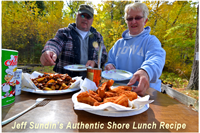 HEY! This is Jeff Sundin's official shore lunch recipe.
HEY! This is Jeff Sundin's official shore lunch recipe.
That's right, the exact one that Jeff serves to his family, most cherished customers and best friends.
This recipe is guaranteed to make your fish taste just like you parked out on a big flat rock on Rainy Lake and cooked them over and open fire!
Ingredients
2 cups of Bisquick • 1 cup of flour • 1/2 tablespoon black pepper • 1/2 tablespoon of cayenne papper • 1/2 tablespoon of onion powder • 1/2 tablespoon of Italian Seasoning • 1 tablespoon of garlic powder • 1 tablespoon of paprika • 1 tablespoon of popcorn salt
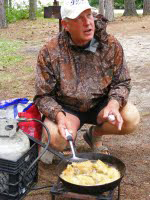 Mix ingredients vigorously in plastic bag until uniform in color. Roll or shake water-moistened fillets in dry coating.
Mix ingredients vigorously in plastic bag until uniform in color. Roll or shake water-moistened fillets in dry coating.
Jeff prefers Canola Oil for frying fish, but substitute your preference; vegetable oil, corn oil, peanut oil or shotening will all work. Use enough oil to fill the bottom of your frying pan to a depth of 1/4 to 1/2 inch, take care to be sure there are no dry areas.
Pre-heat cooking oil, frying pan fry in skillet at 340 to 350 degrees on each side until golden brown. Don't overheat, avoid burning!
By the way, did you know that you can >> Book A Guided Fishing Trip With Jeff?
Removing the Lateral Line and Spike Bones From a Walleye Fillet
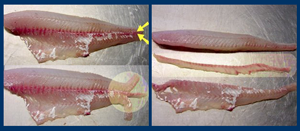 The lateral line, which is often referred to as the "mud-line", allows fish to perform certain sensory functions through a layer known as epithelial cells. The layer of darker flesh is clearly visible running lengthwise down the center of each fillet.
The lateral line, which is often referred to as the "mud-line", allows fish to perform certain sensory functions through a layer known as epithelial cells. The layer of darker flesh is clearly visible running lengthwise down the center of each fillet.
Contained within the lateral line is a row of tiny "pin" or "spike" bones. The importance of removing these small bones varies based on both the size of the fillet and the method of cooking them.
Frying small size fillets, lets say from walleye up to about 16 inches or so, often dissolves or softens the small bones to the point that they are not offensive to your dinner guests. Cooking at lower temperatures, 325 to 340 degrees allows deeper penetration and longer cooking time for the hot oil to dissolve the bones.
The lateral bones seldom fry out of larger fillets, especially when used in recipes that include baking, broiling or flash frying. Personal tastes vary, but these days, many find these small bones to be offensive and removing them is never a bad idea.
Preparing to "Un-Zip" the Lateral and Spike Bones: To begin the process of removing the lateral line, use your fillet knife to make a small cut about 1/8 inch wide and 1 inch long on each side of the visible lateral line. Don't cut too close to the line or you'll have trouble getting the two halves to separate easily.
After making the cuts, it's simple to grasp the top and bottom half sections of the fillet and pull them apart. You'll see the lateral line that contains the spike bones separate itself from the fillet as you "un-zip" the fillet.
The Finished Walleye Fillet: After you've "un-zipped" the fillet, you'll have two completely bone free sections. The thin strip that you've removed from the center contains the small spike bones and is discarded.
Removing this lateral line, especially on larger fish can also help reduce any contaminants that could be contained in this fatty tissue. The likelihood of contamination varies from one watershed to another. The State of Minnesota provides frequent updates at the "Lake Finder" section of the Minnesota DNR website. Click here to view Minnesota >> Fish Consumption Advisories.
Almost all of the fish found in Minnesota waters have lateral lines similar to the ones discussed here. Anglers planning to prepare Perch, Bass, Crappie and panfish can treat their dinner guests to delicous "bone-free" dining by following the same routine.
Northern Pike rquire a bit more attention, but removing their lateral bones, aka Y-Bones, can be easily accomplished with practice. One great tutorial about removing Y-Bones from pike is contained within this video >> Outdoor Bound Fishing For Eater Pike on Lake Winnie
Basic Pan Fried Walleye - Simply Delicious Home Recipe
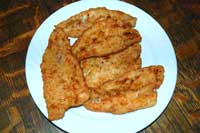
This simple recipe is perfect for folks who love fish and don't want to taste anything else. The mild, light coating lets all of the sweet Walleye flavor shine through and it's so easy that anyone can make perfet walleye every time.
2 Eggs - 1 Cup Milk - 1/2 Tsp. Black Pepper - 1/2 tsp. Salt - 2 Cups White Flour - Canola Oil (or your favorite vegetable oil).
Mix the eggs, milk, black pepper and salt in a mixing bowl. Dip the Walleye fillets in the milk/egg bath and then roll the fillets in flour. Let the fillets stand on a plate for a few minutes while you heat your cooking oil to about 340°F. Place fillets in hot oil and fry one side until golden brown, flip and fry the other side until the fillet will not fold, buckle or break when lifted gently with a fork. . Do not overheat oil! Fillets should sizzle briskly, but to avoid burning, take care that the oil does not smoke while cooking.
Joe and Carol Oliver's Coconut Fish 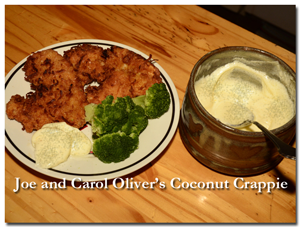
Ingredients For Fish Coating: Chilli Powder 1-1/2 Tsp • Black Pepper 1/4 Tsp • Garlic Powder 1/4 TSP • Dry Mustard 1/4 Tsp • Flour 1 Cup • Cracker - or - Bread Crumbs 1 Cup • Shredded Coconut 1 Cup
Egg Wash: 2 Eggs • 1/4 Cup Milk (whisked to a froth) • Vegetable Oil, Peanut Oil, or Canola Oil (your choice).
*Pictured - Crappie Fillets (Substitute Walleye, Northern Pike or Panfish Fillets)
Ingredients For Fish Coating: Chilli Powder 1-1/2 Tsp • Black Pepper 1/4 Tsp • Garlic Powder 1/4 TSP • Dry Mustard 1/4 Tsp • Flour 1 Cup • Cracker - or - Bread Crumbs 1 Cup • Shredded Coconut 1 Cup
Egg Wash: 2 Eggs • 1/4 Cup Milk (whisked to a froth) • Vegetable Oil, Peanut Oil, or Canola Oil (your choice).
Using seperate bowls: Combine Coconut and Cracker Crumbs, Stir thoroughly until well mixed.
Mix Flour and dry seasonings thoroughly, sift if desired. Once fillets and and all of the ingredients are ready to start dipping.
- Coat fillets with the seasoned flour.
- Dip coated fillets in egg wash.
- Roll fillets in Coconut mix.
- Pre-heat cooking oil to 350 degrees and fry fillets until golden brown. Serve with flavored Mayonnaise. Don't overheat, avoid burning!
Ingredients for flavored mayonaise
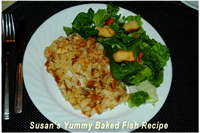
Susan's Baked Walleye Recipe
Ingredients
6 Walleye fillets 1 cup olive oil, divided 6 ounces butter, melted 3 cups Bread Crumbs, French Bread hand crumbled 1 cup whole wheat bread, hand crumbled salt and pepper 1-1/2 cups Parmesan cheese.
Heat 1/4 cup olive oil in pan. Salt and pepper fillets and saute for about 2 - 3 minutes on each side until just done. Place in 9 X 13 glass pan and cover fillet's with bread crumb mixture. Place in oven for 10 - 15 minutes until brown on top.
Pre heat oven to 350. Crumble fresh bread to a fine mixture. Use crusts. Add Parmesan to bread mixture with melted butter and 1/4- 1/2 cup olive oil. Just enough to make bread crumbs moist.
Beer Batter Walleye
2 Lbs. Walleye Fillets 1 Cup Plain White Flour or FryCrisp™ 1 Tsp Salt 1 Tsp Baking Soda 1 Can Beer (flat) 1 Egg Your Favorite Cooking Oil: Canola, Peanut, Shortening or Vegetable Oil.
Wash Fillets and cut into serving size pieces. Mix dry ingredients, then add egg and stir in beer until consistency is like thick gravy. In a deep skillet or deep fryer, pre-heat oil to 350 Degrees. Place battered Walleye pieces in hot oil and fry until golden brown. Walleye is fully cooked when pieces float to the top of hot oil. Remove fish from oil and drain on paper towels.
Note: For extra crispy beer batter, substitute FryCrisp™ instead of white flour. By the way, FryCrisp™ also makes wonderfull onion rings! For really thick batter, coat the Walleye pieces with dry flour before applying the batter.
Do You Know that you can post your own helpful hints to our fishing reports page on facebook? YES! You Can! You don't have to tell us your secrets, just go ahead and brag a little when you get a whopper! Click ... >> Fishing Reports Minnesota .
 And ... did you know that Jeff's Thursday Morning Program is available for two weeks after the air date? Yes, you'll never need to miss the show.
And ... did you know that Jeff's Thursday Morning Program is available for two weeks after the air date? Yes, you'll never need to miss the show.
Click the image and then select the 6:00 hour on Thursday. Scroll in to about 6:20 AM and you're in business!
Jeff Sundin is a full time, professional fishing guide, outdoor writer and photographer. Book Jeff for guided fishing trips, for fishing seminars, fishing promotions and media events. Click here >> learn more about Jeff Sundin.
Home | Current Fishing Report | Saved Fishing Reports | Favorite Lakes | Fishing Articles Section | Recipes | Rates Services | Gift Certificates | Contact | For Sale | Links | Sitemap |
"The Early Bird Fishing Guide" Jeff Sundin - Fishing Blue Books, LLC 715 Byington Ave, LaPrairie, MN 55744 218-245-9858
Email copyright©2020 Fishing Blue Books, LLC All Rights Reserved - last revised 09-25-2020